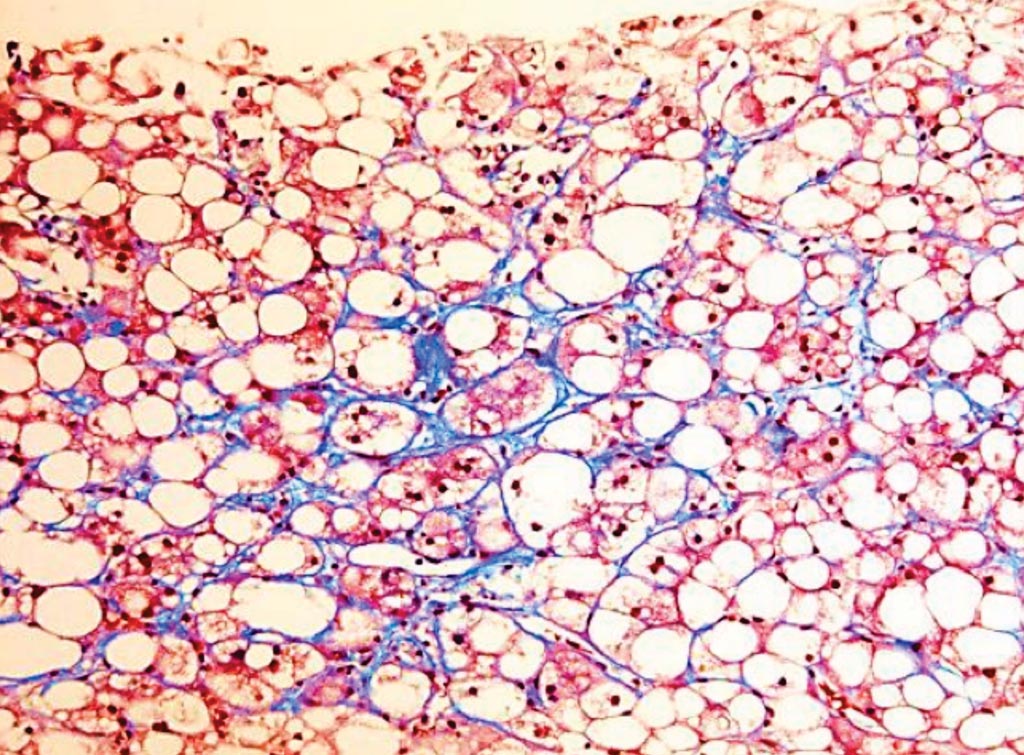C‐Peptide Associated with NAFLD Inflammatory Progression
By LabMedica International staff writers
Posted on 27 Sep 2019
Non-alcoholic fatty liver disease (NAFLD) is characterized by an abnormal accumulation of fat in the liver, due to causes other than excessive alcohol use. NAFLD is a continuum of liver abnormalities, from non-alcoholic fatty liver (NAFL) to non-alcoholic steatohepatitis (NASH).Posted on 27 Sep 2019
Adults with type 2 diabetes and higher C-peptide levels are more likely to develop simple nonalcoholic fatty liver disease and nonalcoholic steatohepatitis compared with those with lower levels. In contrast, those with higher C-peptide levels are less likely to have advanced fibrosis.

Image: A histopathology of non-alcoholic fatty liver disease showing fibrosis pattern around hepatocytes (Photo courtesy of University Hospital “Marqués de Valdecilla”).
Scientists at Shanghai Jiao Tong University School of Medicine (Shanghai, China) conducted a cross-sectional study with 4,120 adults with type 2 diabetes from the Huangpu and Pudong Districts in Shanghai (mean age, 67 years; 56.5% women). C-peptide, total cholesterol, triglycerides, low-density lipoprotein (LDL) cholesterol, high- density lipoprotein (HDL) cholesterol, fasting plasma glucose, alanine aminotransferase and aspartate aminotransferase were measured from blood samples. The team also recorded waist circumference and blood pressure to establish the presence of metabolic syndrome and used ultrasound to evaluate steatosis.
The investigators reported that compared with those with C-peptide levels of 1.12 ng/mL or less, probable NASH was more likely to be identified in participants with C-peptide levels of at least 2.06 ng/mL (OR = 5.28) and those with levels between 1.53 and 2.05 ng/mL (OR = 3.95 and 1.13 and 1.52 ng/mL (OR = 1.91.) Simple NAFLD was more likely to be identified in those with C-peptide levels of at least 2.06 ng/mL (OR = 4.55) between 1.53 and 2.05 ng/mL (OR = 3.21) and between 1.13 and 1.52 ng/mL (OR = 2.08) compared with those with lower levels. The odds of inflammatory progression were 1.34 times higher for every standard deviation increase in C-peptide (OR = 1.34). Fibrosis status was evaluated using the NAFLD fibrosis score, which identified 485 participants with a probable presence of advanced fibrosis. The odds of were lower for those with C-peptide levels of at least 2.23 ng/mL ((OR = 0.59). They also found that fibrotic progression odds were lower for those with C-peptide levels of at least 2.23 ng/mL (OR = 0.74).
The authors concluded that significant but opposite associations between C‐peptide and inflammatory and fibrotic progression of NAFLD was observed. Understanding islet hormone changes during type 2 diabetes and differentiating the stage of NAFLD may help to personalize treatment strategies for NAFLD patients with type 2 diabetes. The study was originally published online on July 27, 2019, in the journal Diabetes Metabolism Research and Reviews.
Related Links:
Shanghai Jiao Tong University School of Medicine













